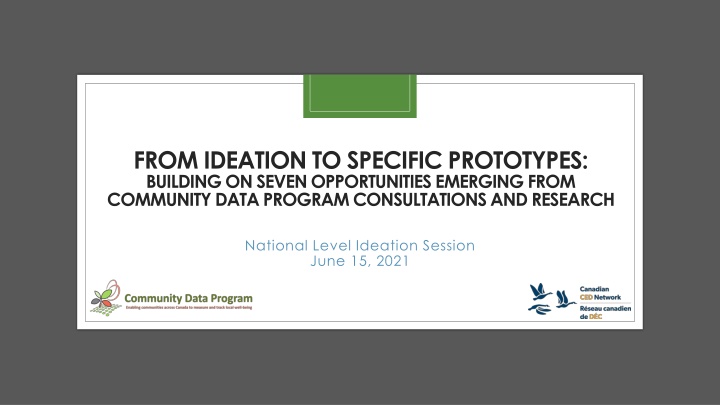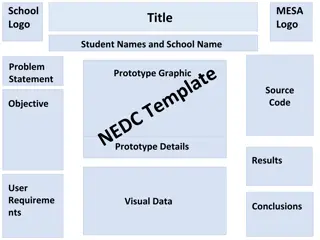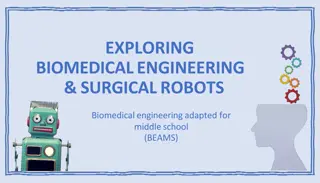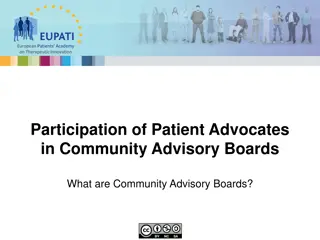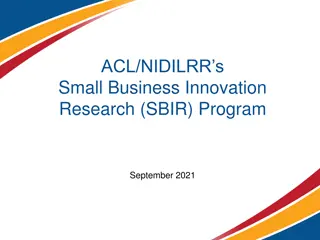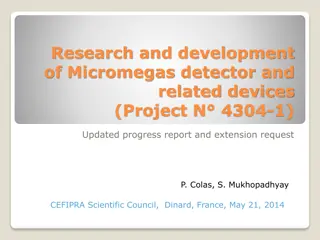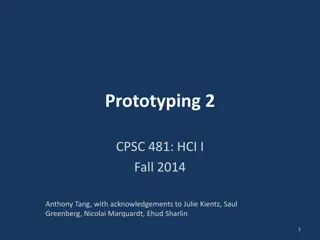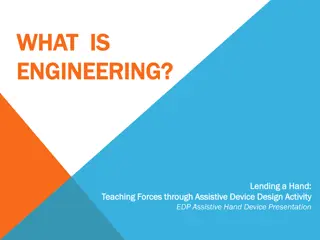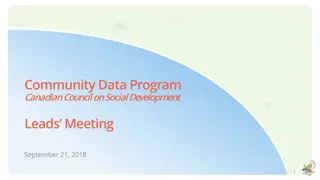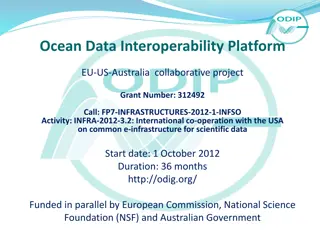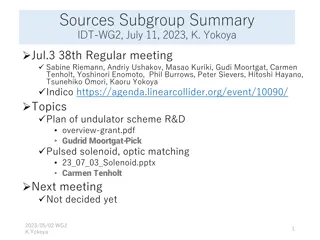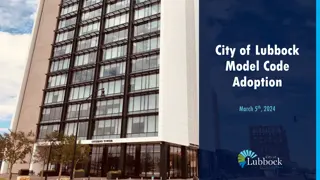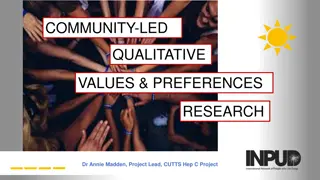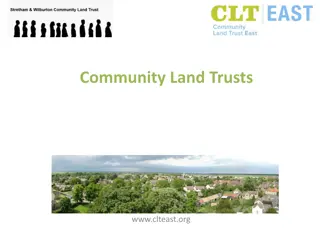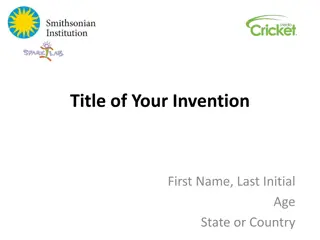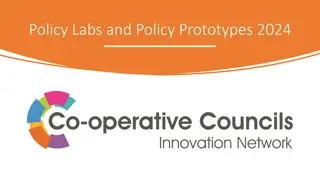Building Specific Prototypes from Community Data Research
Process of moving from ideation to specific prototypes by building on seven opportunities emerging from community data research consultations. The session covers defining prototypes, discussing priority clusters, and planning next steps. Learn about different types of prototypes and examples of their use in various industries.
Download Presentation

Please find below an Image/Link to download the presentation.
The content on the website is provided AS IS for your information and personal use only. It may not be sold, licensed, or shared on other websites without obtaining consent from the author.If you encounter any issues during the download, it is possible that the publisher has removed the file from their server.
You are allowed to download the files provided on this website for personal or commercial use, subject to the condition that they are used lawfully. All files are the property of their respective owners.
The content on the website is provided AS IS for your information and personal use only. It may not be sold, licensed, or shared on other websites without obtaining consent from the author.
E N D
Presentation Transcript
FROM IDEATION TO SPECIFIC PROTOTYPES: BUILDING ON SEVEN OPPORTUNITIES EMERGING FROM COMMUNITY DATA PROGRAM CONSULTATIONS AND RESEARCH National Level Ideation Session June 15, 2021
Welcome & Introductions We will be using Mural Board again! https://app.mural.co/t/purkismurals4571/m/ctlabs8714/1613158 781799/1b6f26b0c5a1bcfe6150c27910d8484e1fef5967?sender=u d35adad844f44c00fa209726 2
Agenda and Objectives 1. Welcome 2. Where are we in the Solutions Lab? (Mary) 3. What is a prototype? (John) 4. What we heard from you - Seven priority clusters (Michel) Time for commentary from the group (World Caf ) Feedback from the micro-labs Voting on favorites 5. Next Steps (Mary) Explore the feasibility of each of the prototypes directed by the National Lab 6. Next Meeting (Mary) September 2021 Present the options for prototypes to develop Oct to Dec is spent developing the prototype(s) 3
Where are we in the process? National session to share ideas from local microlabs & confirm prototyping approach Lessons Learned Roundtable / Road map engagement session National Insight Generation Workshop To Be Confirmed 22 Apr. 2021 14 Sep. 2021 7 Dec. 2021 8 Mar. 2022 2 Mar. 2021 15 June 2021 9 Nov. 2021 8 Feb. 2022 National level ideation session followed by microlabs engagement of local stakeholders ideation sessions Sharing project results and transition to post- project implementation Prototyping activities workshop To Be Confirmed
WHAT IS A PROTOTYPE
Prototypes Type Description Example Rapid A process to help innovators make ideas tangible, learn by doing, and quickly test whether they hold promise for further development. A new group of professionals and clients of the Family justice system develop and sketch out a half-dozen different ways that the legal services can be made more affordable for low-income Family. Slow A process to develop and test a new idea or model that requires changes in the capacity or culture of the innovating organization in order to succeed. An oil and gas company diversifying into other forms of energy technology (e.g., solar, thermal, wind) must also build new skills, networks and knowledge in order to be successful in those industries. Probing Developing and testing an idea primarily to help groups learn more about the complex system in which they are operating and/or trying to change. Once the experiment is over, the prototype is thrown away in the sense it may not be further developed. An environmental group develops a clean technology prototype to surface the kind of regulatory barriers and opportunities involved with introducing new technology to the market. Exploratory An early form of prototype, usually a visualization of a concept or idea, tested to determine whether it warrants further development and testing in the field. A group of local foundations interested in testing a collaborative granting process create a story board that describes each step in detail. It then tests the feasibility of the process with a role-playing exercise with prospective grantees. Developmental An applied or field test of an idea, either the entire model or a specific component, in the real world. A local transit authority expanding its light rail transit line tests the compatibility of its new signaling system with the signaling systems of the older line using several types of relational software. Incremental A building block approach where an innovator adds and tests components of a more complex model or solution incrementally over time. A construction company interested in building net zero ready homes develops, tests and refines different elements of the housing unit over time (e.g., water, electrical, heating). It adds and integrates each element as it emerges until the house is considered net zero ready. Evolutionary Built in an iterative and incremental manner in an effort to more fully develop and refine a model or intervention. May result in prototype 1.0, 1.1. 1.2, 2.0, 3.0, etc. A cell phone company develops successive versions of a new cell phone to test customers responses to an ever more sophisticated set of features. 6
SEVEN KEY OPPORTUNITIES
Seven Key Opportunities: 1. Conceptualizing housing data via the lens of a measurement framework: assessing current and potential indicators. 2. Filling data gaps: Five specific opportunities. 3. Developing data access and visualization tools to meet a spectrum of local data analysis capacity. 4. Reaching more local decision-makers. 5. Data advocacy: sustained engagement of Statistics Canada and CMHC. 6. Offering time-tested data-related tools to CDP members. 7. Funding the resulting roadmap: building on existing revenue streams and exploring new ones.
1. Conceptualizing housing data through the lens of a measurement framework Part 1A - Effectiveness assessment of alternative program investments in achieving broad policy goals: Broad policy - National Housing Strategy: oCreating livable communities oTaking steps towards to advance the right to housing oSetting out concrete targets and reporting on the results oSpearheading innovative new housing research, data and demonstration projects oSeeking out input from voices that haven t always been heard oAdopting a whole-of-government approach to jobs, healthcare, and preventing violence against women.
1. Conceptualizing housing data through the lens of a measurement framework Part 1A - Effectiveness assessment of alternative program investments in achieving broad policy goals: Some questions for prototype development: oHow should/can the CDP offer data for indicators on each of these policy goals? oWhat does the CDP already have in the way of prototypes for the data-focused elements of these goals? oWhich among these goals are covered in priorities identified by CDP research and consultation?
1.Conceptualizing housing data through the lens of a measurement framework Part 1B - Effectiveness assessment of alternative program investment for achieving specific outcomes/targets: Program Objectives - National Housing Strategy: oCut chronic homelessness in half oRemove 530,000 families from housing need oInvest in the construction of up to 125,000 new affordable homes.
1.Conceptualizing housing data through the lens of a measurement framework Part 1B - Effectiveness assessment of alternative program investment for achieving specific outcomes/targets: Some questions for prototype development: oWhat metrics must be collected, for what locations, and how often to assess achievement of these ambitious targets? oTo what extent can Census data be applied to measurement in each case? oWhat methodologies can be applied to go beyond purely production-related assessments of outcomes?
1. Conceptualizing housing data through the lens of a measurement framework Part 2A Policy lifecycle perspective: Do these perspectives on data merit prototype development?
1. Conceptualizing housing data through the lens of a measurement framework Part 2A Policy lifecycle perspective: How is Information Used? What Information is Useful?
1.Conceptualizing housing data through the lens of a measurement framework Part 2B Comprehensive Indicators perspective: Demonstrating Value Checklist of Affordable Housing Indicators Do these indicators of affordable housing merit prototype development?
1.Conceptualizing housing data through the lens of a measurement framework Part 3 Continuum perspective: Scope of topics for metrics envisaged by a Housing Continuum : oShelter for people experiencing homelessness, with an increasing emphasis on permanent shelter. oSubsidized rental housing in relation to Core Housing Need oAffordable market rental housing in relation to accommodation at below average market rents, affordable unit retention. oFull market-rate rental housing with emphasis on supplier in relation to new arrivals into urban markets and secondary unit availability. oAffordable home ownership with emphasis on avoiding long-term rental subsidies and generating wealth among moderate-income households. oMarket-rate home ownership with emphasis on reducing impacts of skyrocketing prices.
1.Conceptualizing housing data through the lens of a measurement framework Part 3 Continuum perspective: Key questions for suppliers of data to ask and answer: oWhat reliable data exist in relation to needs/requirements for each of these types of policy and program initiative? oWhat data do program managers currently rely upon in directing their resources for maximum effectiveness? oWhat results of long-term outcomes exist in each case?
Housing continuum perspective-graphic used by City of Guelph ON:
2. Filling Data gaps: Five specific CDP opportunities 1. Disaggregating housing demand data by CMHC priority demographic groups (Housing those in Greatest Need) o More tables disaggregated by age, race, immigration status. disabilities o Further disaggregation of indigenous status (First Nations, Inuit, Metis) o Sexual Orientation : CCHS includes question on sexual orientation o Veterans (2021 census includes question on participation in the military) 2. Building a full picture of the local rental universe o Secondary rental market o Vacancies (by size, type and rent) o Rental data for communities <10,000 population o Short-term rental (by size, type and rent) 3. Building a fuller picture of the home resale market in smaller communities 4. Filling data gaps using data modelling and administrative data collection o Using small area estimation techniques for modelling data to CD, CSD and CT geographies o Web-scraping tools for rental costs o Deeper mining of municipal permitting data to measure annual change in stock 5. Measuring movement from chronic homelessness to permanently housed o Partnering with Canadian Alliance to End Homelessness to reach homelessness data networks
3. Developing data access and visualization tools to meet a spectrum of local data analysis capacity: For the data savvy: Better designed IVT tables using Beyond2020: GIS- friendly, easier to find in the catalogue, regularly advertised through newsletters and notifications For those with some data analysis capacity: Interactive Multi- Dimensional Dashboards: Tableau/PowerBI as data access tools e.g., the Community Recovery Dashboard For the modest capacity data users: Click, Copy and Paste Infographics: Tableau/Power BI as interactive infographic e.g., CDP Thematic Dashboards on specific topics of interest
4. Reaching more local decision makers Expanding the Community Data Consortium Model to reach rural communities? Developing a rural data network modelled after the CDP Immigration Network Consortium? Engagement via professional publications with large readerships?
5. Data advocacy: sustained engagement of Statistics Canada and CMHC Addressing reluctance to produce customized data sets e.g., CSD population projections; household projections Improving knowledge of existing and emerging administrative data sets - e.g., municipal building permit data; Housing Statistics Program; accessory suites Encouraging data-sharing agreements with provinces to fill NHS-relevant data gaps in areas of provincial jurisdiction (e.g., mental health and addictions, property assessment, energy)
6. Offering time-tested data-related tools to data users Program management software tools predominate currently, e.g., for social housing property management. Assessment of ways to apply standard statistical software to housing issues is in its infancy. What other kinds of tools may find a market locally and on what financial basis?
7. Funding the road map: Building on existing revenue streams and exploring new ones Potential Funding Structures: Community Data Consortium fee structure? Network Consortium fee structure? Organizational membership fees? Fees for individual accounts, regardless of sector? Data product download fees? Sponsorship for data networks or new products (Potential sponsors could include: FCM, ESDC, Infrastructure Canada, Community Foundations of Canada, private foundations, appropriate private sector companies).
MURAL BOARD BREAKOUT GROUPS
Break out group discussion Session Overview: 4-5 break out groups. Using Zoom breakout rooms and Mural to facilitate group discussions. Facilitatory will go through the questions
Visit www.communitydata.ca or Send us an email at information@communitydata.ca 30
